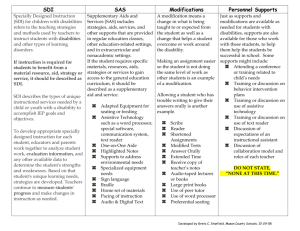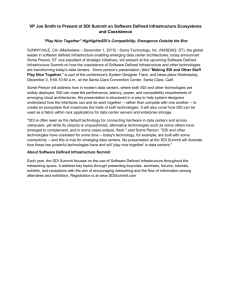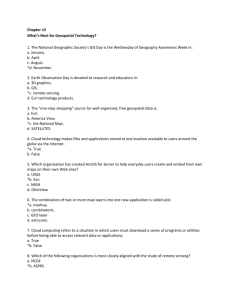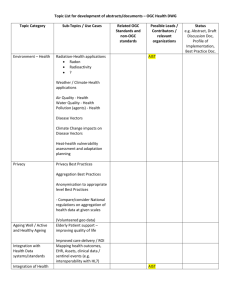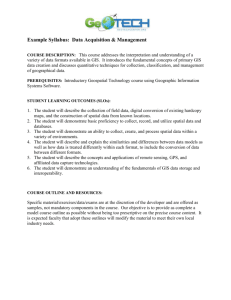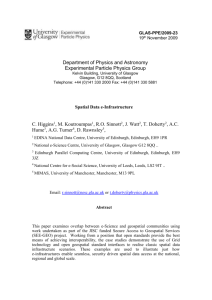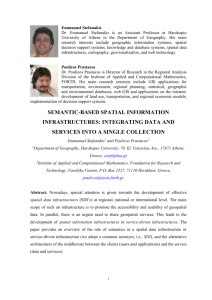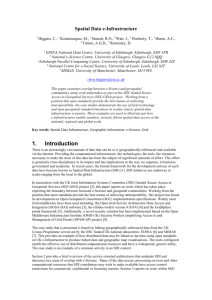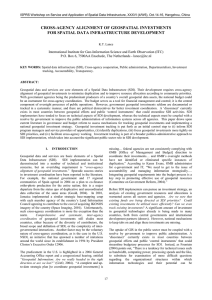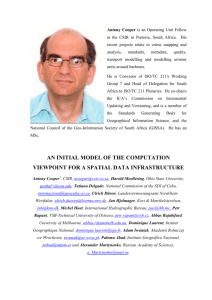building spatial data infrastructure at county level using open software
advertisement
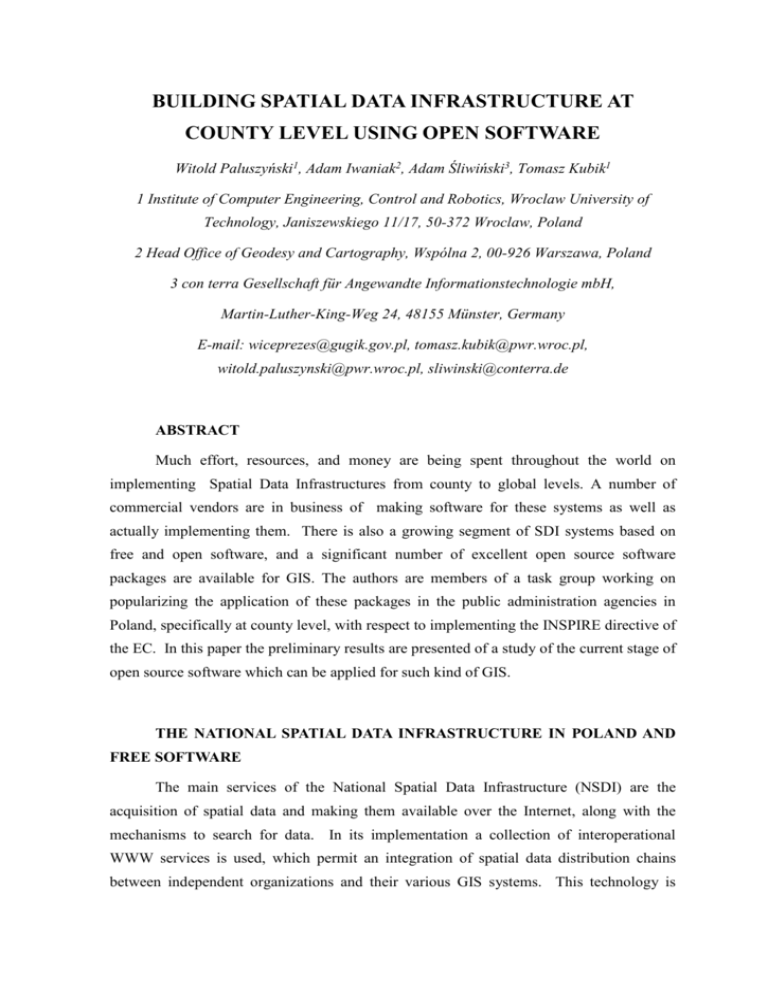
BUILDING SPATIAL DATA INFRASTRUCTURE AT COUNTY LEVEL USING OPEN SOFTWARE Witold Paluszyński1, Adam Iwaniak2, Adam Śliwiński3, Tomasz Kubik1 1 Institute of Computer Engineering, Control and Robotics, Wroclaw University of Technology, Janiszewskiego 11/17, 50-372 Wroclaw, Poland 2 Head Office of Geodesy and Cartography, Wspólna 2, 00-926 Warszawa, Poland 3 con terra Gesellschaft für Angewandte Informationstechnologie mbH, Martin-Luther-King-Weg 24, 48155 Münster, Germany E-mail: wiceprezes@gugik.gov.pl, tomasz.kubik@pwr.wroc.pl, witold.paluszynski@pwr.wroc.pl, sliwinski@conterra.de ABSTRACT Much effort, resources, and money are being spent throughout the world on implementing Spatial Data Infrastructures from county to global levels. A number of commercial vendors are in business of making software for these systems as well as actually implementing them. There is also a growing segment of SDI systems based on free and open software, and a significant number of excellent open source software packages are available for GIS. The authors are members of a task group working on popularizing the application of these packages in the public administration agencies in Poland, specifically at county level, with respect to implementing the INSPIRE directive of the EC. In this paper the preliminary results are presented of a study of the current stage of open source software which can be applied for such kind of GIS. THE NATIONAL SPATIAL DATA INFRASTRUCTURE IN POLAND AND FREE SOFTWARE The main services of the National Spatial Data Infrastructure (NSDI) are the acquisition of spatial data and making them available over the Internet, along with the mechanisms to search for data. In its implementation a collection of interoperational WWW services is used, which permit an integration of spatial data distribution chains between independent organizations and their various GIS systems. This technology is based on standards which permit authorized users to directly use distributed computer systems. At county level applying this technology mainly implies implementing the web services such as the OGC Web Map Service, OGC Web Feature Service, and OGC Catalog Service for the Web, to make available the reference data of selected elements from the parcel and building registry database and other thematic products created by the county geodesic agency in the Internet/Intranet. It is important that these data be referenced by metadata (according to the ISO 19115) and registered in catalog servers. The Polish structure of the geodetic and cartographic service consists of three levels: central, province (16 centers), and county level (369 centers). The central level is under the state administration, but the province level has a dual nature (it is under state administration and self-governments), while the county level remains the self-governments task only. This structure is complex and to achieve interoperability between its nodes the widely accepted standards should be used. The Head Office of Geodesy and Cartography of Poland makes efforts to ensure this, for example by creating the working groups: Working Group for National Data Infrastructure, Working Group for Metadata, International and National Standards, and Working Group for Open Software. The Head Office of Geodesy and Cartography initiated the GEOPORTAL.GOV.PL project aimed at providing access to national geodetic and cartographic resources. The main target was to provide georeferential data such as: orthophoto, roads, building, address points, parcels, and catalog services delivering the description of data stored by the service. Following the INSPIRE directive these data should satisfy the needs of local communities and building the information society. There is a requirement for creating SDI facilities at county offices, providing geospatial services with search, view, and access abilities that are reachable from the central geoportal playing the broker role. The resources of central and district levels should be accessible from a central geoportal. It is hoped that the project will assume the role of the main access point to geospatial data in Poland. In many countries, both in the European Union and America, a lot of effort is being invested in the development of free and open software for spatial data processing (providing, searching, accessing, and utilizing) in distributed systems. Such projects are most often undertaken by the leading universities and research institutions. The software and technologies emerging as the result of this work are by default based on the international standards of ISO 19100 series and the OGC standards, rather than on private closed standards, which is often the case with the commercial software. In some Western European countries, notably in Germany, Spain, and Italy, the public government agencies support the creation and implementation of such systems based on free software. Consequently, the main customer of these products and the beneficiaries of these projects are the country and local governments, which fulfill the duties set forth for them by the law. In Poland, somewhat differently, most SDI implementations are based on commercial software, and the free software based solutions are infrequent (for example, GRASS). However, efforts are being undertaken to change this situation. The authors of this paper are involved in a project, initiated and sponsored by the Head Office of Geodesy and Cartography of Poland, whose goal is to build a team of experts who will devote efforts to adapt to Polish standards a number of free software packages for SDI and GIS, and to help implement a number of "seed" NSDI implementations built using free software for county governments across the country. There is work to be done with configuration and preparing modules to process the Polish data formats, implement the Polish metadata profile, provide the Polish language user interface, and supplementary documentation for data administrators. FREE AND OPEN SOURCE SOFTWARE The idea of "free software" developed in the 1980-ties and was formalized by Richard Stallman who created in 1985 the Free Software Foundation to support this idea and movement. Stallman proposed the model of distributing all software along with the full source code version, and right to use it in any way the user saw fit, along with the binary software. For that purpose a "Copyleft license" was created, which expressed such software distribution model in lawful terms. The original Copyleft license was used in distributing one of the first excellent free-software packages, the Gnu C compiler. The original idea of free software has much evolved since its creation. The Copyleft license has transformed into what is now called the Gnu Public License (GPL) which is a model proposed by many for distributing new software packages. It combines the ideas of free software, which is software with a license to use it for any purpose and in any way, with a copyright guaranteeing that such rights granted by the original creator of the software cannot be removed from a derivation of the software by someone who modified it, or who perhaps just distributed it. Since the word "free" has created some confusion due to the meaning of "free" as "costless", there appeared alternative terms, such as "libre software", "open source software" (OSS), "free and open source software" (FOSS), and even "free and libre open source software" (FLOSS). There also appeared a proliferation of other "free", "open", and "public" license statements, which are alternative to GPL, some of which quite similar in spirit to the GPL, and compatible with it, and some containing significant other conditions or restrictions. Finally, a variant of the GPL license worth noting, the Lesser Gnu Public License (LGPL), was created to accommodate the growing segment of free software which are libraries rather than runnable programs. In some cases, the creators of such software consider it more advantageous to relax the strict conditions of the GPL license and permit commercial software to use their libraries. FREE SOFTWARE IN GOVERNMENT Somewhat unexpectedly, free software, which started as a revolutionary movement, became the object of interest of large organizations, such as commercial enterprises which were consumers rather than producers of software, various public offices, government agencies, national governments, the military, and even such entities as the European Union. The users of the software realized that, in many cases, not being able to verify the precise functionality of their system, and consequently not being able to trust that it supports "our side", may render it less useful, and in some cases completely useless to the user. This realization came at a time of intense development of free software, and such packages as the Linux operating system, which could be carefully and thoroughly inspected before use, and even formally verified, if needed. Consequently, some public government agencies started using free software, or started studies meant to prepare a switch to such software. Another aspect of public administration using open software is its adherence to the accepted standards, both current, and future adoptions. The software systems for handling spatial data, incur very high cost of data acquisition, and, when fully implemented, the data stored in them are the main component of the system value. When such system is implemented using private unverified standards and data formats of a commercial software vendor, the safety of the investment in data is dubious. GIS SYSTEMS BASED ON OPEN SOFTWARE The rapid expansion of free software is one of the important phenomena of the I.T. industry which started in the 1990-ties, and continues accelerated growth. It can be also observed in the process of answering increasing demands for an easy access to a wide range of geospatial data where the free software becomes valuable source of building blocks for National Spatial Data Infrastructures. The volume and importance of open software solution may vary from a single library to the software suites accompanied by documentation and training material allowing easy deployment of an SDI node. A solution encapsulating all necessary software to publish and analyze geospatial and non-geospatial data over a secured infrastructure sometimes is referred to as "SDI-in-a-Box". Two most popular solutions of this sort are: GIS Knoppix (http://www.sourcepole.com/sources/software/gis-knoppix/) and GeoNetwork (http://geonetwork-opensource.org/). The former is a self-booting Linux CD containing office productivity tools along with a full set of GIS tools (GRASS, PostgreSQL, PostGIS, MySQL, QGis, UMN MapServer, Qgis, TerraView Jump Thuban, MapLab, MapDesk). The latter is a metadata and catalog tool that supports the ISO19115 and OGC Catalog standards. It is available on a DVD that includes a wide range of other Free and Open Source Software of interest to the geospatial community (among others GeoServer, MapServer, gvSIG, uDig, QGIS, GRASS, MapBuilder, MapLab, ka-map, PostGIS and NASA World Wind) for Windows, Linux and Mac OS X. It is noticeworthy that on the freegis.net page there are over two hundred different software projects related to the geospatial data processing listed. They comprise different areas of use and application. OPEN STANDARDS ASSURING INTEROPERABILITY IN THE GEOSPATIAL DOMAIN One of the strong requirements of the information society is to have an easy access to the global data from a user's desk. To fulfill these requirements the data providers make them available in the form of Internet services with standardized interfaces. The services are accessible by the users through the Internet sites, with the aid of Internet browsers, and can be "chained" to perform useful functions. In such architecture, a single SDI (Spatial Data Infrastructure) node, providing all the information the user may need from one site, is not sufficient. The SDI is starting to emerge as a common architectural framework spread around the world. This framework is based on open standards from various organizations, i.e. OGC, ISO, OASIS, W3C what assure its interoperability. The standards specify some abstractions agreed upon by the software developers and user communities or define common, vendor independent, application profiles. Most of the geospatial related standards with application profiles come from OGC and are closely related to ISO 191XX series of standards. The key OGC standards like WMS, WFS, WCS were designed to store and provide access to geospatial data while the CSW standard deals with metadata. Such standards make use of XML-based data encoding formats and languages for server-toclient and client-to-server data transfers. These include GML, FE, SLD, Web Map Context, URN, URL, SensorML, WSDL, BPEL, etc. Communication in these schemas uses nonproprietary Internet standards (World Wide Web) protocols, namely HTTP GET, HTTP POST, and Simple Object Access Protocol (SOAP). Thus on the server side there might be various technologies applied while the service interface should be kept standardized. Even without versioning, the number of standards used in SDI is large. These mentioned here display just the tip of the iceberg of the collection of standards, some related to others, and some not. OPEN SOFTWARE CATEGORIZATION The maturation of open standards, increasing availability of free software tools, and sponsorship by large software companies, has made strong impact on the evolution of the geoinformatics. Open source software plays more important role there than ever before. This software spreads out over an area from a simple library to complex systems, from simple geocomputation algorithm implementations to data acquisition and visualization. Its contribution in building spatial data infrastructure at the county level has several means. In this context the open source software has to be seen as something more than just some publicly available, free and ready to deploy solutions. To get a clear view on the subject all the aspects by which the open source software comes into play in the GIS and SDI field should be analyzed. In this paper we provide only some clues on that matter. The categorization of the open source software is not obvious and sometimes might be confusing. Having this in the mind lets start categorization by concerning the area of software application. With such criterion we can distinguish the software for: geospatial analysis, statistical analysis, geo-feature modeling (in 2D and 3D), data conversion to and from various formats, projection and coordinate transformation, viewing or visualizing, specialized data processing (for remote sensing, GPS, etc.), data acquisition and maintaining, and other. Regarding the level of complexity of the solutions proposed we can name the following (in the increasing complexity order): libraries of functions, packages of components, programs (console tools, GUI enabled applications), systems (closed, extensible with plug-ins, possessing scripting abilities). The open source software may be used to establish or enable a common computing and communications infrastructure. In particular to achieve interoperability the software should follows some formal specification. Focusing on this parameter the open source software can be divided into: software based on vendor specific standards, software conforming international standards (OGC, ISO, OASIS, W3C) . Concerning the implementation of multi-access the categorization can be done as follows: desktop application (communication mainly based on the files exchange), web solutions (Internet portals and services). The open source software domain has a heterogeneous character. The set of technologies used is originated by: programming and scripting languages (C, C++, C#, J#, VB, Java, Java Script, Python, Tcl/Tk, Perl, PHP, FORTRAN, Delphi, Ruby, SWF), and frameworks (JAVA, .NET), web solutions (HTTP, XML, SOAP, UDDI, WSDL, OGC OWS (GML, WMS, WFS, CSW, WCS, ?), etc.), FGDC). data centric solution (SQL, data bases with spatial option, Dublin Core, The web pages devoted to the free software presentation can be found under the following link: http://freegis.org. The software there is organized using similar criteria as those discussed above. A COMPLETE OPEN SOURCE-BASED SDI IN TWO HOURS As an experiment in the application of available open software to build a complete SDI system, a number of open software packages was selected, downloaded, and configured initially, and their functionality was verified. The assumption was to achieve a basic functionality of a distributed GIS system for the application in a public administration agency at a local level, with the capabilities of: data visualization, integration, verification, and modification. The basic technical architecture of the system is as presented in Figure 1. Installation steps 1 RDBMS installation (15') Install PostgreSQL 8.1.4 without PostGIS extension and install PostGIS 1.1.5 2 Data migration using FME Pro (10') 3 GeoServer 1.3.4a installation and configuration (30') 4 uDig 1.1 RC5 installation - data visualization and manipulation (15') 5 ArcGIS installation - data visualization and integration (15') 6 CartoWeb 3.3 WAMP5 1.6.5 preinstalled - installation and configuration (30') 7 CartoWeb with FireFox (1') Experiment summary The purpose of the experiment was to demonstrate the technologies implementing the technical architecture specified above, based mostly of open software, as an alternative to commercial solutions. However, the approach taken here was pragmatic, rather than dogmatic. For some tasks commercial software was used since it was deemed a convenient and time-saving option to using purely open-source solutions. Figure 2 shows the structure of the GIS system thus created. CONCLUSIONS Diverse technical environments and comprehensive user demands require using several different products in implementing GIS systems for the distributed applications, such as SDI. Among these, the open source software products offer a viable and attractive alternative to the commercial solutions for such systems, which is especially significant for public administration agencies. However, advanced architectures, such as those totally oriented toward implementing standards-complying web services may require using and integrating free and open source software with commercial closed source products. ACKNOWLEDGEMENTS This research was supported in part by the Ministry of Science and Higher Education through grant 4T12E01030. REFERENCES 1. K.Buehler, OpenGIS Reference Model, Open GeoSpatial Consortium, Ref.no. 03-040, 2003 2. P.Burrough, I.Masser (editors), European Geographic Information Infrastructures, Taylor & Francis, London, 1998 3. D.Gotlib, A.Iwaniak, R.Olszewski, Jedna referencyjna baza danych topograficznych, GEODETA no 1, 2005, pp. 8-11 4. R.Groot, J.McLaughlin, Geospatial Data Infrastructure, Oxford University Press, 2000 5. F.Harvey, A.Iwaniak, SDI Development in Poland - First Results from a National Survey, Roczniki Geomatyki, tom III, z.3, Warszawa, 2005 6. L.Lessig, Open Source Baselines: Compared to What?, in: Government Policy toward Open Source Software, edited by Robert W. Hahn, AEI-Brookings Joint Center, Washington, DC., 2003 7. D.D.Nebert, The SDI Cookbook, Version 2.0, Global Spatial Data Infrastructure, 2004 8. I.Simonis, A.Śliwiński, Quality of Service in a Global SDI. Proceedings of the 8th International Conference for Global Spatial Data Infrastructure Cairo, Egypt, (GSDI-8; April, 16- 21), 2005 9. A.Śliwiński, A.Iwaniak, M.Nowak, P.Merta, Infrastruktura danych przestrzennych (SDI) inaczej, cz.VIII. Wolny Software, Geodeta, no 7, 2006, pp. 40-42 10. A.Śliwiński, A.Wytzisk and I.Simonis, The Free and Open Source Software Initiative 52°North - Fueling National and International Standardization Efforts. In: GeoInformatics Vol. 8, No 6, 2005, pp. 40-42 11. A.Wytzisk, A.Śliwiński, Quo Vadis SDI? In: Proceedings of the 7th AGILE Conference on GI Science. Heraklion, 2004, pp. 43-49
